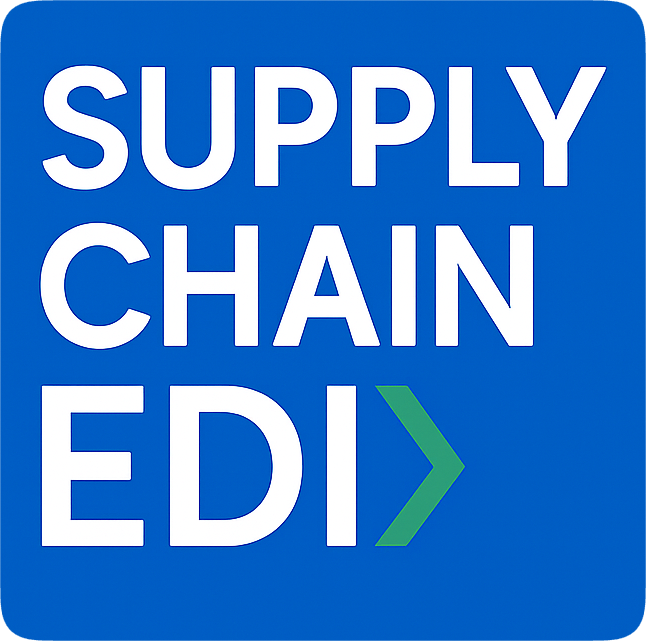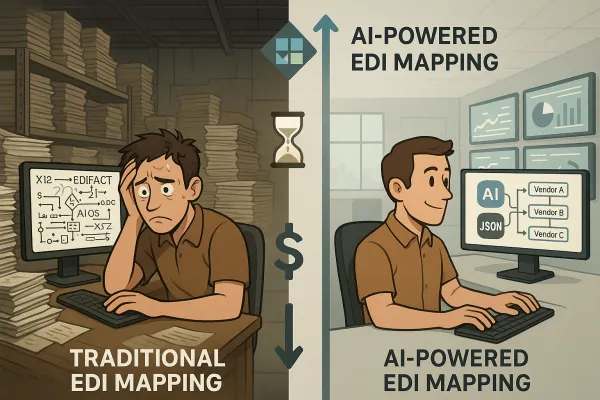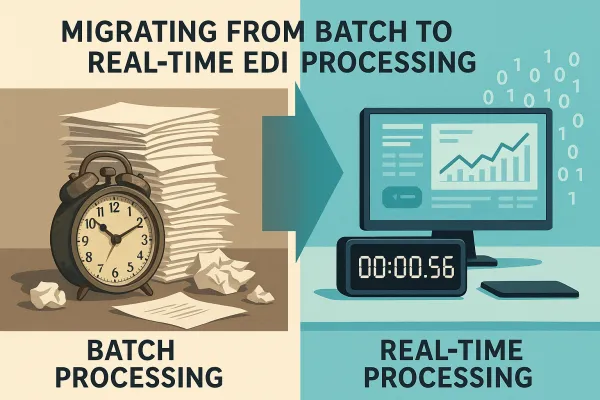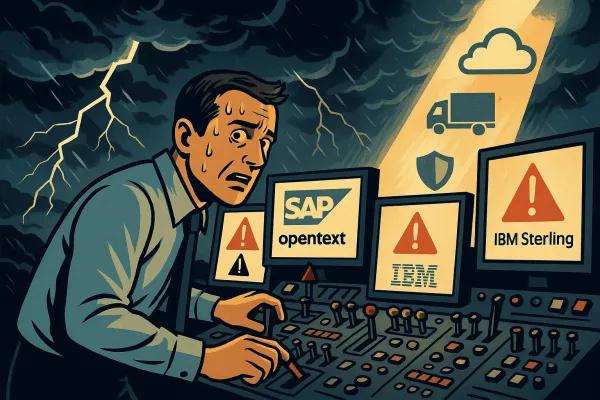The EDI Partner Onboarding Crisis: How to Cut Integration Time from 6 Weeks to 5 Days Using Automation and Pre-Built Templates in 2025

Nearly two-thirds (63%) of IT decision-makers say that the EDI onboarding process takes too long because of customized partner requirements. Up to 47% of IT managers say that slow EDI supplier onboarding is currently keeping their businesses from capturing new revenue opportunities. The math here gets painful quickly: Nearly a quarter of companies (24%) are losing $500K or more to integration issues related to their supply chains.
Your suppliers wait four to six weeks just to get onboarded with traditional EDI vendors. In practice, that theoretical 1-2 week timeline often stretches to 1-2 months or longer. Meanwhile, your competitors with modern automated EDI onboarding are bringing partners online in days, capturing deals while you're still stuck in testing cycles.
The Hidden Cost of Slow EDI Onboarding That's Killing Revenue Growth
For approximately 40% of organizations, new-partner onboarding takes more than 30 days, according to a survey by research firm Ovum. But the real damage goes beyond lost time. Every week of delay means missed revenue opportunities, frustrated trading partners, and deals that go to competitors with faster integration capabilities.
Here's what slow EDI partner onboarding actually costs you:
Lost deal velocity matters more than you think. When a potential supplier or customer wants to start trading electronically, they need to move fast. A retail customer launching a new product line can't wait six weeks for EDI integration - they'll find another supplier who can connect within days.
Partner frustration compounds over time. Some vendors may not have the necessary technical knowledge to implement EDI solutions, causing delays in the onboarding process. In these cases, businesses must offer additional training or technical support to help vendors meet EDI standards and integrate smoothly into the system. But if your onboarding process is already complex and time-consuming, you're asking partners to invest even more resources before seeing any return.
Resource drain hits your team hard. Traditional EDI onboarding requires dedicated staff to handle mapping, testing, validation, and troubleshooting. That's expensive talent tied up in repetitive tasks instead of strategic initiatives.
Why Traditional EDI Onboarding Takes 4-6 Weeks (The Breakdown)
The typical EDI onboarding process follows six major steps, each creating potential bottlenecks:
Requirements gathering comes first. You need to understand the partner's document formats, communication protocols, business rules, and compliance requirements. This alone can take 3-5 business days if both parties respond quickly.
Connection setup follows, where you establish communication channels, configure security protocols, and test basic connectivity. Network issues, firewall configurations, and security policies can extend this phase significantly.
Document mapping becomes the biggest time sink. This includes identifying the types of documents to be exchanged (like invoices or purchase orders), as well as any industry standards that must be met. Each document type requires custom mapping between your internal formats and the partner's requirements. Complex mapping can take days or weeks.
Testing requires both partners to work on the same timeframe. You send test documents, wait for feedback, make adjustments, and repeat. If your partner has limited EDI experience, expect multiple test cycles with extensive hand-holding.
Validation and certification add another layer. You need to verify that all document types process correctly, error handling works as expected, and compliance requirements are met. This monitoring period typically lasts 2–10 business days, depending on transaction volume.
Production deployment seems simple but often reveals new issues. System load, timing differences, and real-world scenarios create problems that weren't apparent during testing.
The 5-Day EDI Onboarding Framework: Automation-First Implementation
Modern EDI platforms are turning this 4-6 week nightmare into a 5-day success story. The secret? Automation tools with pre-built templates and validation processes to expedite onboarding and minimize errors.
Cloud-native platforms enable faster deployment by eliminating infrastructure setup time. Orderful's cloud EDI platform streamlines EDI onboarding from months to less than 5 days, simplifying integrations while ensuring 100% compliance. Instead of configuring on-premise servers and networks, partners connect through secure cloud endpoints that are already optimized and tested.
Pre-configured trading partner profiles make a huge difference. When Orderful onboards a trading partner, we do it once. This means that we take their guidelines and communication channel requirements and we publish them onto our platform. This process takes us less than a day. Once the new trading partner is set up in the Orderful Network, anyone can reuse those requirements immediately.
Automated mapping dramatically reduces setup time. Orderful offers a feature called integration assistance that makes EDI data mapping simple. We consolidate your trading partner's inbound unique requirements into one format which includes a super-set of all the data you will receive. This enables your developer to integrate your back end systems once to our API, consuming data from all your trading partners in a common format.
The key insight here: instead of custom-building each integration from scratch, modern platforms provide reusable components that dramatically reduce implementation time.
Pre-Built Templates and Self-Service Portals: Your Automation Toolkit
Onboard new trading partners without writing a single line of code. With Cleo's EDI solution, you get the Cleo Network, AI-powered mapping, and pre-built EDI and API integrations that automate transactions directly into your back-office systems (ERP, TMS, WMS, shipping software, and more).
Self-service onboarding portals let partners initiate their own setup process. They can select document types, specify business rules, and configure basic settings without requiring your technical staff. This parallel processing approach eliminates the back-and-forth delays that plague traditional onboarding.
Pre-built connector libraries save massive amounts of development time. Instead of building custom integrations for each major ERP system, modern EDI platforms provide ready-made connections to SAP, Oracle, Microsoft Dynamics, NetSuite, and dozens of other business systems.
Transport Management System integration has become increasingly important. Solutions like Cargoson, alongside established players like MercuryGate and nShift, offer pre-built connectors to major shipping carriers. This means your EDI onboarding can include carrier connectivity from day one, rather than treating it as a separate integration project.
Automated validation processes catch errors before they become problems. Instead of discovering mapping issues during testing, modern platforms validate document structures, field formats, and business rules in real-time as you configure them.
Overcoming the SME Onboarding Challenge: Leveling the Playing Field
Some vendors may not have the necessary technical knowledge to implement EDI solutions, requiring additional training or technical support to help vendors meet EDI standards and integrate smoothly into the system. This creates a significant challenge: how do you onboard smaller partners who lack EDI expertise without dramatically increasing your support burden?
Traditional EDI systems often create a two-tier system where large partners with dedicated EDI teams get onboarded quickly, while smaller partners struggle with complex requirements they don't understand. This limits your supplier diversity and can shut you out of relationships with innovative smaller companies.
The solution involves treating partner education as part of your competitive advantage rather than a support burden. When you can help smaller partners get connected quickly and successfully, you build stronger relationships and gain access to suppliers that your competitors can't reach.
Guided onboarding workflows walk less experienced partners through each step with clear explanations of what they need to do and why. Instead of sending a 50-page EDI implementation guide, modern platforms break the process into digestible steps with contextual help at each stage.
Template-based configuration reduces the technical complexity partners face. Rather than requiring them to understand X12 or EDIFACT standards in detail, they can select from pre-configured templates based on their industry and business model.
Cloud-Based EDI Solutions: The SME Game-Changer
This modern approach to EDI offers greater scalability, reduced IT overhead, and faster onboarding of trading partners. Rather than maintaining your own servers or hiring internal staff to manage EDI operations, a cloud EDI provider handles the entire infrastructure.
Cloud-based platforms eliminate the capital investment barrier that historically prevented smaller companies from implementing EDI. Instead of purchasing servers, software licenses, and hiring specialized staff, they can access enterprise-grade EDI capabilities through a subscription model.
Multi-carrier shipping software examples like Cargoson, combined with cloud-based TMS platforms, give smaller companies access to the same logistics automation that larger enterprises have built internally. This democratization of advanced capabilities means your smaller partners can integrate more quickly and provide better service.
Automatic updates and maintenance reduce the ongoing burden for partners with limited IT resources. When you're using cloud-based EDI, both you and your partners benefit from continuous improvements without having to manage upgrades or patches.
Scalable pricing models let smaller partners start with basic capabilities and add features as they grow. This removes the "all-or-nothing" decision that often delays adoption.
Implementation Roadmap: Your 5-Day Onboarding Action Plan
Here's how the accelerated onboarding process actually works in practice:
Day 1: Assessment and Setup Initiation
Partner completes automated readiness assessment through your self-service portal. They specify document types, communication preferences, and business requirements. Your platform automatically validates their requirements against available templates and identifies any custom mapping needs. Pre-implementation checklist gets generated automatically.
Day 2: Automated Configuration and Testing Setup
System generates initial configuration using pre-built templates. Basic connectivity testing occurs automatically. Partner receives test credentials and access to sandbox environment. Any configuration issues get flagged for resolution.
Day 3: Document Testing and Validation
Automated test suite runs through all required document types. AI-powered validation checks formats, business rules, and compliance requirements. Partners can view test results in real-time and make adjustments without waiting for manual review.
Day 4: Integration Verification
End-to-end testing with actual business systems. Integration with existing TMS platforms gets verified. Error handling and exception processing tested. Performance validation under expected load conditions.
Day 5: Production Deployment
Final configuration review and approval. Production credentials issued. Initial live transactions monitored for any issues. Support team provides immediate assistance for any problems.
The key difference from traditional approaches: most of these activities happen in parallel rather than sequentially, and automation handles the routine validation tasks that normally require manual review.
Measuring Success: KPIs and Optimization Strategies
Track onboarding velocity by measuring time from initial contact to first successful production transaction. Target should be 5-7 business days for standard integrations, with more complex requirements taking no more than two weeks.
Partner satisfaction scores matter more than you might expect. Partners who have positive onboarding experiences tend to increase transaction volumes faster and provide better collaboration on process improvements.
First-time success rate indicates how well your automated processes work. You should see 80%+ of partners successfully completing onboarding without requiring significant manual intervention.
Support ticket volume during onboarding reveals where your automation needs improvement. If you're getting lots of questions about the same topics, those are opportunities for better templates or clearer self-service guidance.
ROI calculation should include both direct cost savings (reduced staff time per onboarding) and indirect benefits (faster revenue recognition, improved partner satisfaction, ability to onboard more partners with existing resources).
Continuous improvement requires regular review of onboarding metrics and partner feedback. Decreasing EDI onboarding times from months to days means going live sooner, resulting in increased revenue and an improved bottom line. Our customers no longer spend their resources reviewing complex guidelines, building one off integrations, going through weeks of manual testing, or managing complex infrastructure. They simply set up an integration once to our platform, test with their partner, and start using our infrastructure that does the EDI heavy lifting.
The transformation from 6-week EDI onboarding to 5-day automated deployment isn't just about faster implementation. You're fundamentally changing how your business approaches partner relationships, moving from a bottleneck-constrained process to a competitive advantage that helps you capture opportunities while your competitors are still stuck in testing cycles.





